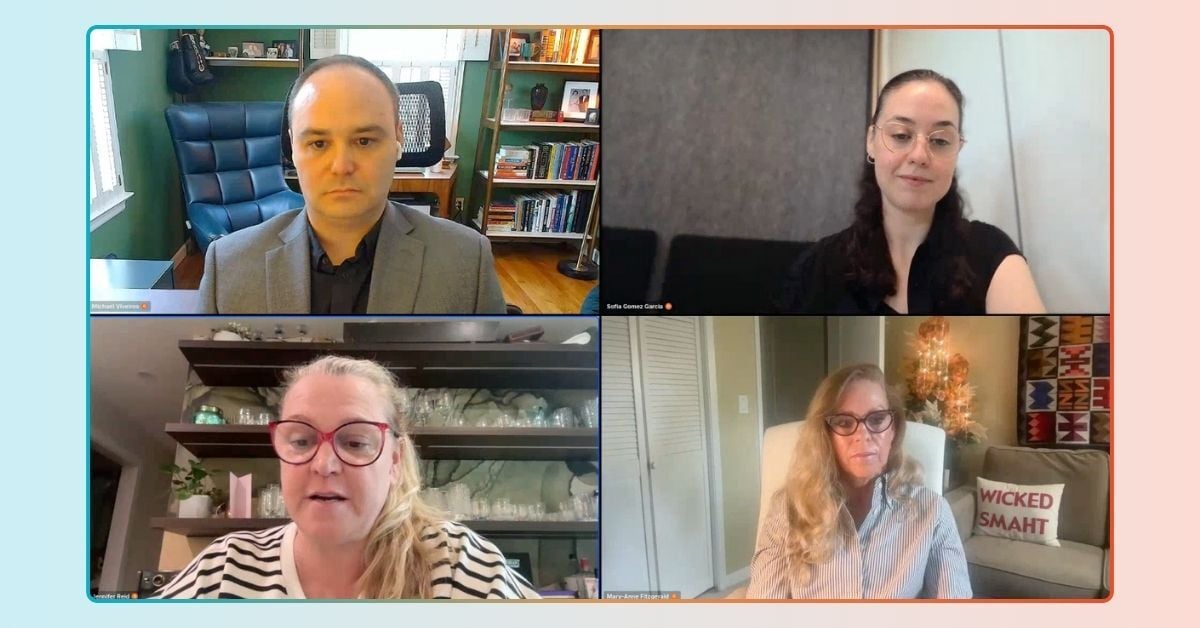
To say that the marketing research and insights industry is undergoing disruption is a huge understatement. We're seeing huge shifts in consumer behaviors, rapid technological innovation, and the rise of artificial intelligence (AI). From tariff-related economic uncertainty to cultural and political polarization, research teams are being challenged to decode not just what consumers do, but why they do it and what's next.
As Mary Anne Fitzgerald, Director of Consumer Insights at Balsam Brands, described during our recent webinar, it’s an era that feels “unsettled, but evolving.”
So, what does it take to thrive as an insights leader in this environment?
That’s the question we explored with Mary Anne, alongside Michael Viveiros, Senior Director of Research at My Code Media, and Sofia Gomez Garcia, Executive Director of Innovation, Special Projects, and Global Community Management at Warner Bros. Discovery. The session was moderated by Jennifer Reid, Co-CEO and Chief Methodologist at Rival Group.
If you’ve been wondering how to stay ahead in the ever-changing world of insights, here are some key lessons from their conversation.
AI has found its way into nearly every aspect of insights, and for the most part, that's a good thing. But ensuring its outputs are trustworthy? That's another matter entirely.
Sofia shared a simple but powerful exercise her team uses when it comes to AI tools:
"Our favorite follow-up question for when we’re working with Copilot or any of those agents is, what was wrong about your answer? And it will provide you a response and will challenge itself."
This simple prompt encourages critical thinking and deeper scrutiny of AI-generated insights.
"Hallucinations are just inevitable, period," Sofia explained. "So you really have to be very discerning on how you interpret the results that you get."
For researchers, this highlights the importance of building AI literacy—not just knowing how to use these tools, but understanding when (and how) to question them. Ultimately, AI works best when paired with human judgment and oversight.
Implicit research methodologies are gaining traction as companies dig deeper into what drives consumer decisions.
"I’m much more of a fan of the implicit measurement of people’s behavior post-exposure,” Michael shared. “And that has been a very, very big tool in my toolkit this year."
For teams that rely heavily on survey-based research, integrating implicit methods can reveal an added, deeper layer—like observing behavior changes after a campaign instead of just asking how people felt.
Sofia echoed this, adding that her team uses implicit research to uncover the “true meaning” behind responses, going beyond surface-level data.
For qualitative researchers, AI is unlocking new possibilities—especially when it comes to analyzing unstructured data.
Michael shared how the Rival platform has reignited his passion for qualitative work:
"I have fallen back in love with open-ended questions. Rival is just so unique because of the way that the platform works. It's all through text messages.... I've never seen so many high quality responses and people going way beyond the scope of the question and giving us a lot more, detail about their lives than we needed for the question. It's really helpful for context.
AI tools—whether within Rival or other platforms like Gemini—make it easier to analyze text responses at scale, preserving the depth and humanity of qualitative research while adding much-needed efficiency.
As budgets tighten, insights leaders are being asked to prove their value more clearly than ever. Proving performance is part of an insight leader's playbook in 2025.
But Michael emphasized the need to balance innovation with pragmatism:
"The strongest case isn’t just ROI because some experiments will fail," he shared. "And if you’re not having failed experiments, then you’re not learning and growing and iterating towards the correct... answer for right now."
So, what's a better approach? It comes back to the bigger picture. Michael explained:
"Insights can really help break through that by connecting the dots between cultural understanding, consumer connection, and purchase behavior. We need to make sure that our work stands out as that compass in unpredictable situations."
By tying insights to business outcomes and cultural shifts, research teams can position themselves as indispensable strategic partners.
A focus on data quality is one of the biggest market research trends in 2025. Heading into 2026, the panelists agreed that well-managed insight communities are key to combating bots and fraud.
“We run a community called the Warner Brothers A List community, and it's very valuable, for organization, both in terms of efficiencies and cost savings,” shared Sofia. “The community has never been more important in our organization because as we continue to do so much quant, we see an uptick in sample fraud, and it's become harder for panel providers to separate bots. When you have a community like ours, the incentive is different… and there is a much lower risk of that type of infiltration of fraud.”
But beyond quality control, using a trusted, top insight community platform also help strengthen relationships with consumers.
“Community has been a lifeline for us in the last year,” Mary Anne explained. About six months after launching their community, Balsam Brands reached out to members for feedback.
“It was so joyful to hear how connected our community members feel to us,” she said.
Mary Anne also shared how simple gestures—like personalized thank-you videos or welcome notes—create lasting emotional bonds:
"We just rerecruited for our community… we did a video just saying welcome to the community… And we'll get notes back, saying, thank you so much. It does create that really strong connection."
When it comes to community management best practices, these personal touches make make a huge difference because they make people feel valued, increasing both engagement and retention.
Michael highlighted another benefit of having a dedicated insight community: strengthening and supporting data-driven storytelling.
“When I think about our insights tech stack, Rival is right in the middle, and that is allowing us to be more agile,” he explained. “We have our foundational tracking studies across almost every industry vertical with the big numbers for the what. But Rival is helping us add a more contemporaneous contextual layer… to fill in some knowledge gaps, but also really help us with our storytelling and add more cultural and community-based context into what the numbers are telling us about the moment in time.”
By blending traditional quantitative tracking with agile, community-based insights, his team is able to bring richer narratives to stakeholders.
Looking ahead, the panelists shared how they’re continuing to secure investment for research by strengthening relationships with key stakeholders.
To start: have a clear mission.
“I've made it very clear that we're just not gonna be supporting marketing; we're supporting the customer,” said Mary Anne.
This broader mandate is made possible through agile research tools and trusted partners. Just as important, you need to maintain relationships with decision-makers and key stakeholders.
“Especially with the Rival platform and getting more studies done and having that authentic voice present, it's now they're kind of expecting it,” she added. “It's constantly, like, ‘what have you done for me lately?’ We have to have our own strong voice. We have to constantly be integrated into the conversation.”
For Sofia, tying research closer to revenue growth has been key to demonstrating market research ROI:
“What's been a 2025 initiative and '26 for sure is that we've really bumped up our work to capture the upside of our business. The research has had a direct impact on anything that grows that revenue,” she said.
In a world defined by change, one thing is clear: the insights function has never been more vital. By blending AI innovation with human empathy, implicit understanding, and authentic community connections, research leaders are not just keeping up with the times—they’re shaping what’s next.

No Comments Yet
Let us know what you think